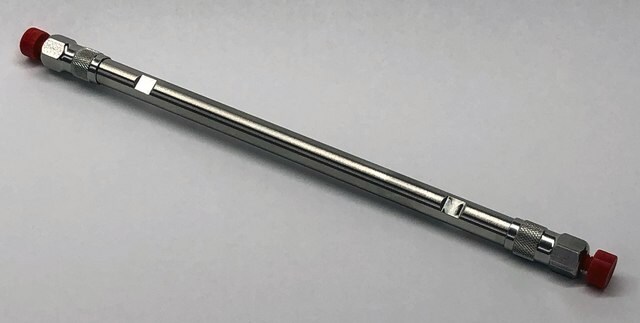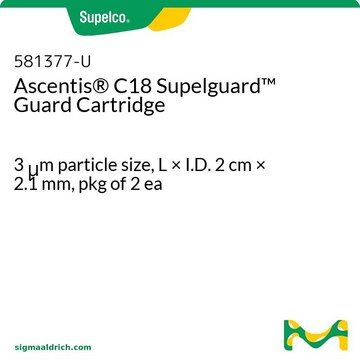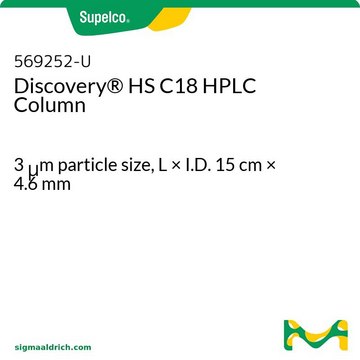581301-U
Ascentis® C18 (3 µm) HPLC Columns
L × I.D. 10 cm × 2.1 mm, HPLC Column
Sinonimo/i:
Ascentis RP18 HPLC Column
About This Item
Prodotti consigliati
product name
Colonna per HPLC Ascentis® C18, 3 μm particle size, L × I.D. 10 cm × 2.1 mm
Materiali
stainless steel column
Livello qualitativo
agenzia
suitable for USP L1 (Similar to Phenomenex Luna C18)
Nome Commerciale
Ascentis®
Caratteristiche
endcapped
Produttore/marchio commerciale
Ascentis®
Confezionamento
1 ea of
Grado di funzionalizzazione
25% Carbon loading
Parametri
≤70 °C temp. range
400 bar pressure (5801 psi)
tecniche
HPLC: suitable
LC/MS: suitable
Lungh. × D.I.
10 cm × 2.1 mm
Area superficiale
450 m2/g
Copertura della superficie
3.7 μmol/m2
Impurezze
<5 ppm metals
Matrice
fully porous particle
silica gel high purity, spherical
Gruppo funzionale matrice
C18 (octadecyl) phase
Dimensione particelle
3 μm
Dimensione pori
100 Å
operating pH range
2-8
applicazioni
food and beverages
Tecnica di separazione
reversed phase
Cerchi prodotti simili? Visita Guida al confronto tra prodotti
Categorie correlate
Descrizione generale
Ascentis C18 è una colonna HPLC di prima scelta estremamente stabile e affidabile che fornisce una forma a picchi simmetrici e un′ottima ritenzione anche con composti difficili.
Applicazioni
- Identification of recombinant human insulin and biosynthetic insulin analogues by multiplexed targeted unlabeled mass spectrometry of proteotypic tryptic peptides.: This study employs the Ascentis® C18 HPLC column for the separation of proteotypic tryptic peptides, allowing the identification of human insulin and biosynthetic insulin analogues through multiplexed targeted unlabeled mass spectrometry. The method demonstrated high specificity and sensitivity, enhancing the accuracy of insulin analysis in pharmaceutical research (Qasem et al., 2019).
- Development and validation of a novel stability-indicating HPLC method for the simultaneous assay of betamethasone-17-valerate, fusidic acid, potassium sorbate, methylparaben, and propylparaben in a topical cream preparation.: Utilizing the Ascentis® C18 HPLC column, this research presents a novel stability-indicating method for the simultaneous assay of multiple compounds in a topical cream. The validated method offers robust stability assessment, critical for ensuring the quality and efficacy of pharmaceutical formulations (Byrne et al., 2014).
- HPLC-DAD and HPLC-ESI-MS/MS methods for metabolite profiling of propolis extracts.: This paper describes the use of the Ascentis® C18 HPLC column in HPLC-DAD and HPLC-ESI-MS/MS methods to profile metabolites in propolis extracts. The column′s performance in separating complex mixtures highlights its utility in natural product research and quality control (Pellati et al., 2011).
- Practical comparison of 2.7 microm fused-core silica particles and porous sub-2 microm particles for fast separations in pharmaceutical process development.: This study compares the performance of the Ascentis® C18 HPLC column with other chromatographic columns for fast separations in pharmaceutical process development. The Ascentis® column provided superior separation efficiency and speed, making it advantageous for high-throughput pharmaceutical analysis (Abrahim et al., 2010).
Caratteristiche e vantaggi
- Ottima ritenzione
- Forma a picchi simmetrici
- Elevata riproducibilità
- Totale compatibilità LC-MS
Note legali
Non trovi il prodotto giusto?
Prova il nostro Motore di ricerca dei prodotti.
Applicazioni
Precolonna
Prodotti correlati
Codice della classe di stoccaggio
11 - Combustible Solids
Classe di pericolosità dell'acqua (WGK)
WGK 3
Punto d’infiammabilità (°F)
Not applicable
Punto d’infiammabilità (°C)
Not applicable
Scegli una delle versioni più recenti:
Possiedi già questo prodotto?
I documenti relativi ai prodotti acquistati recentemente sono disponibili nell’Archivio dei documenti.
Chromatograms
application for SPE, application for LC-MSIl team dei nostri ricercatori vanta grande esperienza in tutte le aree della ricerca quali Life Science, scienza dei materiali, sintesi chimica, cromatografia, discipline analitiche, ecc..
Contatta l'Assistenza Tecnica.







